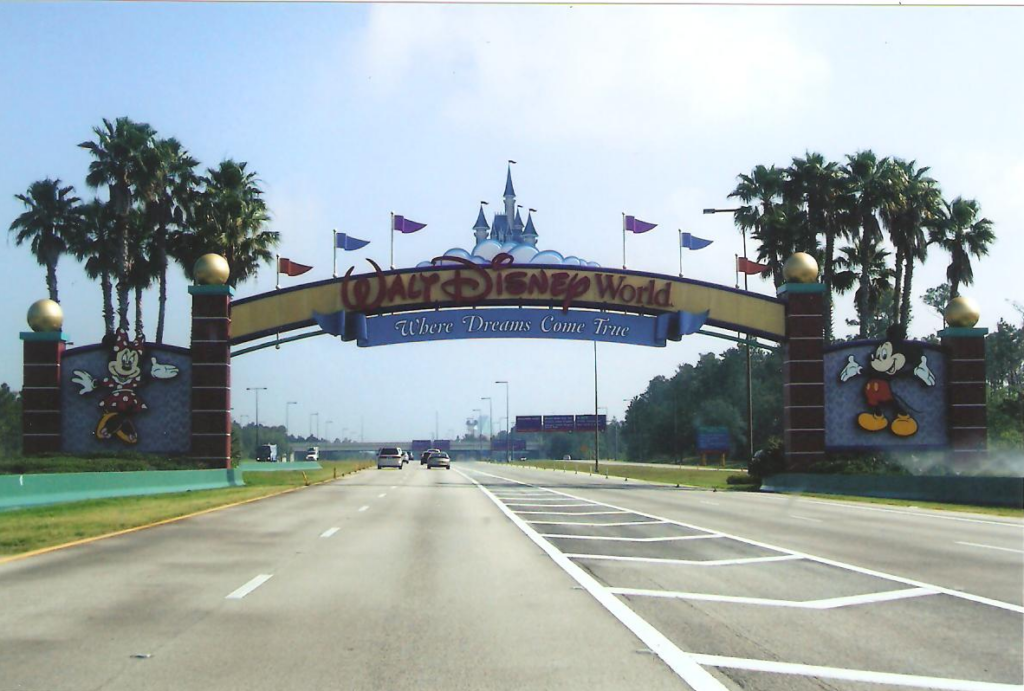
Welcome to Disney World! Photograph courtesy of Wikimedia Commons.
1.
Once I had to go to Disney World with my small children. On the way to the airport our taxi driver exhibited signs of Obsessive Disney Disorder—when he found out where we were going he started obsessively describing and listing and explaining everything that had to do with Disney World, even though he was a grown man.
We stayed at the Portofino Bay Hotel, a Disney-owned property that is a replica of the storied village on the Italian Riviera. There were imitation Renaissance churches and Mediterranean piazzas clustered around a fake harbor with old Fiats parked on the cobblestones and fishing boats moored in the fake bay. Outside cafés ranged on the harbor, serving espresso under green-and-white striped awnings. Italian cypresses were planted along the pools. If you didn’t know it was a Disney replica of a real place, it would have to be characterized as being extremely tasteful and lovely. So you did tend to get confused between: Is this a theme park of Italy or is it just lovely and pleasant.
There is a REAL Florida out there that is TRULY historic. I madly drove out to find the REAL Orlando, forgetting my phobia of freeways. After almost getting killed (horns blasting at my side, cars swerving out of my way), I did find the real Orlando. It is situated on several lakes lined by turn-of-the-last-century Victorians and bungalows. I went to the history museum. The number one industry in central Florida is cattle. Has anyone in Florida ever seen a head of cattle? No. But maybe that was before Disney.
I went to my first theme park. Not Disney World but another theme park we noticed from the side of the road. Our small children were foaming at the mouth to go to theme parks, they were in the promised land, their dreams were all coming true: theme parks. This one looked maybe more palatable to me than Disney World. It was called the Holy Land Experience. It was founded by a Messianic Jew and meant to replicate Jerusalem in the year A.D. 66. The buildings were ocher-colored like the desert sand with a roseate glow, amid papyrus groves and palms. The background was the I-4 freeway and the giant Mall at Millenia across the street.
You’re directed to a tent among the palms where an Alec Guinness look-alike wearing the garb of an ancient priest starts giving a scholarly lecture on the difference between the tribe of Levi and the Levitical priesthood, whatever that is, nonchalantly tossing off pedantic theological distinctions. You start thinking that the guides must be scholars or priests in real life, because they seem very learned and sad. They shuffle about in their flowing robes throwing bits of food to the birds, looking as if they just stepped out of the Bible. The gift shop sells books that have titles like Three Views on the Rapture: Pretribulation, Prewrath, or Posttribulation.
Then, in the tradition of theme parks everywhere, a booming narration begins from a recording. But unlike at theme parks everywhere, this recording is reciting Hebrew prayers and explaining the prewrath version of the Rapture—whatever that is.
The next show is in the “Scriptorium” and deals with cuneiform texts, Babylonian tablets, Hebrew scrolls, and other biblical antiquities. What about the poor sapsuckers who got roped into this thinking they were going to Disney World, more or less, now trapped in the Scriptorium discussing the condemnation of Spanish rabbis in fifteenth-century Oxford?
It was sort of ike an old-fashioned wax museum. The brochure calls it a “highly-themed” (translation: you’re in a theme park), “climate-controlled walk-through experience.”
Doors and gateways opened electronically at each new chamber while the booming prerecorded narrator intoned about the bondage of religious traditionalism, the early reform movement that produced the daring first translation of the Latin Bible, and other things like that. Again I pitied the sapsuckers who came to ride on little trains and see life-size stuffed animals, instead stuck in the Scriptorium discussing the bondage of sin.
At the end there was an incredibly cheesy finale inside a replica of the Hagia Sophia with sleazy portraits painted on velvet of religious figures and plush curtains electronically rising in successive waves, accompanied by the booming prerecorded baritone narrator quoting scripture, with the Ten Commandments written in neon on the ceiling (in Hebrew), culminating in an explosive tribute to Jesus Christ.
The high-tech epilogue involved a careening computer room meant to simulate modern times while the omnipotent voice still droned on about the word of God. This led to the gift shop. Mad rush to the gift shop to buy Bibles and prewrath explanations of the Rapture. The cashiers, who also appeared to be preaching, were dressed in the flowing robes of monks.
I asked one of them if the workers here were theological scholars or had religious affiliations. She said they were Christians. But your founder is Jewish, I mentioned. He’s a Messianic Jew, she pointed out.
“So do all denominations work here?” I pursued.
“Oh yes, we have everything—Christians, Jews—so long as they’re Christian.”
The children were richly satisfied. For some reason, children love theme parks no matter what they are about, even if what they are about is Babylonian tablets and outraged Spanish rabbis in the fifteenth century.
We ate lunch at the Oasis Palms Café. Two guys dressed as Roman soldiers cruised by, looking like something left over from the set of Spartacus.
2.
“Mom, would you want to have Slime poured on your head?” asked one of my daughters, then age four. We were taking them to a place where this might actually happen.
MGM Studios, supposedly the least crowded part of Disney World, celebrates the film industry, according to my husband. The Disney film industry, to be more precise. Contradictory to the buildup from my husband, it was the most crowded place that I have ever seen, aside from Bourbon Street on Mardi Gras Day.
It all starts in the parking lot. The parking lot itself is so crowded that you lose hope of ever fully traversing it. Then you come to a tram. Even at the tram there are waves and waves of lines.
Eventually you arrive at the entrance gates on the little tram. Finally you enter the park. Well the upshot of it all is this: After about six hours of waiting in really long lines for the dorky, anticlimactic and in some cases sort of quaint little shows, my husband said we could leave. My heart rose and I headed toward what I thought was the exit.
I noticed even more dense crowds forming. Barricades appeared. I darted quickly out into the street to leave. I was stopped by officious Disney guides saying, “You can’t be here right now.”
Why not? Because the parade was starting. The one where Mickey Mouse and Donald Duck and other characters come through. A screeching girl chattered inanely on a loudspeaker about it.
“You can’t be here right now,” they said repeatedly with stern yet scary affectless expressions.
“Well then where am I supposed to be? I’m trying to leave this place.”
“You can’t be here right now,” said officious people in red jackets tensely.
Behind the barricades the dense crowds surged. The officious Disney people kept harassing me. Security people told me to leave the street, so I had to press into the crowd behind the barricades.
The crowd surged like a giant wave covering me. I took a step through a solid mass of people. When my feet left the ground one of my shoes was gone. I cowered down to retrieve it.
“Is this your bracelet?” asked a man pointing to a crushed shard on the ground.
Now, when you’ve been to Mardi Gras Day every year as a small child you know what it’s like to get trapped in a mob. But it isn’t an angry mob. This was an angry mob. It wanted Mickey. It wanted Daffy. It wanted the flesh from my body. Finally I surged through to the back.
I told my story again to a couple of Disney people standing under an official gazebo. “I’m trying to leave this place,” I said, “and I’m trapped.”
“Go that way,” said officious people in red coats. “Try over there,” they said vaguely.
One of them took pity on me and volunteered to escort me to Guest Relations—which sounds like a euphemism for something ominous. It was adjacent to the entrance/exit, and I sat there forlornly. They wouldn’t let you broadcast an announcement to search for your lost family, otherwise there’d be a hysterical stream of announcements constantly drowning out Mickey and Daffy.
After experiencing stark anxiety and regret for a while about how I might never see them again, lost in Disney World—they showed up on their way out from the parade. They loved it, they adored it, they saw Daffy, they saw Goofy, everything was peachy.
I went back to the hotel and healed. I read while drinking espresso at outside cafés in the sun. They went to another theme park the next day but I sat that one out. I waited for them at the dock of the little harbor built to look like Italy, which indeed it does, and Florida healed me. It did. It was the weather, the sun, the green. Can the blue sky be fake? Theme parks make you exist in a questioning netherworld of reality.
Nancy Lemann is the author of Lives of the Saints, The Ritz of the Bayou, and Sportsman’s Paradise. “Diary of Remorse” was published in the Fall 2022 issue of the Review.


 8 months ago
15
8 months ago
15 






 Bengali (Bangladesh) ·
Bengali (Bangladesh) ·  English (United States) ·
English (United States) ·